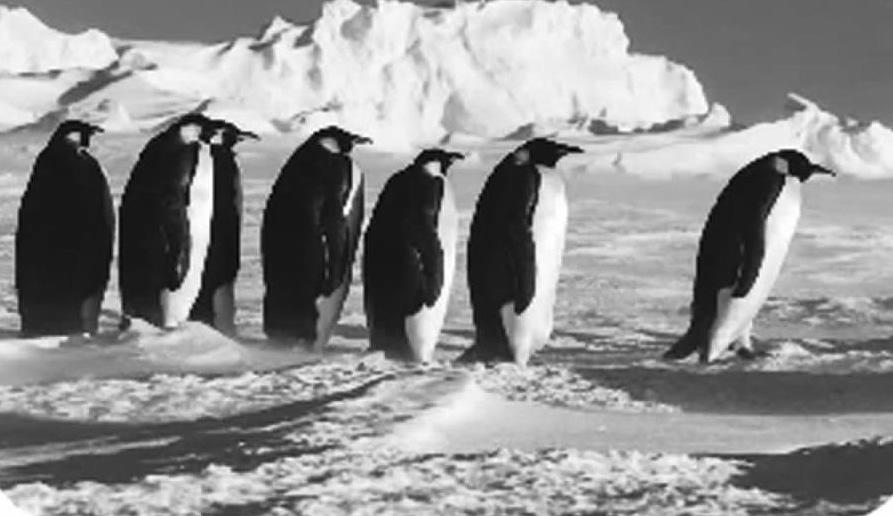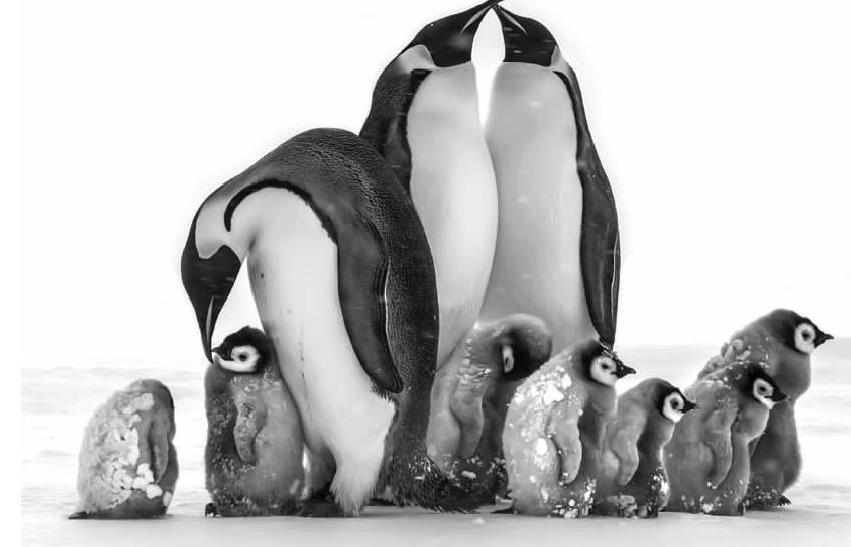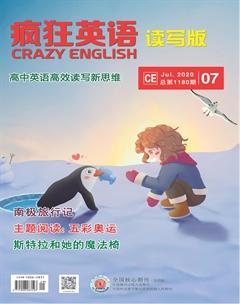帝企鹅可能在21世纪末消失
王晶



帝企鹅是地球现存19种企鹅中最大的,其形态特征是脖子底下有一片橙黄色羽毛,向下逐渐变淡,耳朵后部最深。冬季它们在南极严寒的冰上繁殖后代,而如今气候变暖对它们带来了巨大的威胁……
Emperor penguins are the largest of the 19 penguin species. “The Emperor penguin is certainly the most iconic of the penguin species,” said Dyan deNapoli, penguin expert and author of The Great Penguin Rescue. “It is the most visually impressive of the penguin species, and is very well?known by millions of people, who fell in love with the species after seeing the award?winning documentary, March of the Penguins.” Emperor penguins are also the hardiest penguin species: They live on the coldest, driest, and windiest place on the planet and breed during the harsh Antarctic winter, when the temperatures can drop to 100 degrees F and the winds can blow 100 mph.
Despite all that, a new study predicts that if climate change continues, most Emperor penguins may disappear by the end of the century. “If global climate keeps warming at the current rate, we expect Emperor penguins in Antarctica to experience an 86 percent decline by the year 2100,” said Stephanie Jenouvrier, a lead author on the paper that was published in Global Change Biology. “At that point, it is very unlikely for them to bounce back.” Jenouvrier and a team of researchers created a global climate model that forecasts when and where sea ice forms and a model of penguin populations to see how colonies may respond to varying sea ice in future climate footprints. However, if countries meet the objectives of the Paris Agreement, Emperor penguins would decline by a less drastic 31 percent.
As with most of the penguin species on Earth today, the number one threat to their survival is global warming. Both poles (the Arctic and the Antarctic) have experienced the greatest increases in temperatures over the last 50 years, notes deNapoli. The second threat to most penguin species today is the overfishing of their food supplies.
DeNapoli notes that there has been a decrease in the amount of sea ice formation in the regions of Antarctica where some Emperor penguins establish colonies to breed and raise their babies. “Many Emperor penguins breed on ice shelves that only form during the Antarctic winter. There have been times in recent years when the ice shelves have melted back faster or sooner than usual. Many of the babies havent completely fledged into their waterproof feathers by the time the ice melts back to the colony, and they are forced into the cold ocean waters, where they die of cold exposure or drowning,” said deNapoli. Another thing that less sea ice definitely affects is food for the penguins. “One of their food sources is krill, and the sea?ice shelves serve as a nursery for the krill. The krill larvae feed on the algae that grow on the underside of the sea ice. When there is less sea ice, fewer krill are produced,” deNapoli explained.
“People can donate to organizations that are working to protect Emperor penguins and other penguin species, and our oceans in general,” says deNapoli. Reducing your impact on the environment, in particular, is something you can do—you can make these tiny changes to lower your carbon footprint every day. “You can also be mindful about reducing seafood consumption as overfishing is the second greatest threat to nearly every penguin species today. Also, avoid using supplements and other products that contain krill or krill oil,” noted deNapoli.
[阅读自测]
1. Why are Emperor penguins the hardiest penguin species?
A. Their appearances are ugly.
B. Their living environment is tough.
C. Their breeding process is too long.
D. Their food sources are quite limited.
2. Why was the global climate model created?
A. To forecast when and where sea ice forms.
B. To predict the climate change in the future.
C. To monitor the changes of penguins population.
D. To see penguins response to climate footprints.
3. Whats the biggest threat to penguins survival?
A. Cold weather. B. A lack of food.
C. Global warming. D. Water pollution.
4. Where do most Emperor penguins breed?
A. In ice caves. B. On ice shelves.
C. In ocean waters. D. On the underside of the sea ice.
文本探究
探究视角1:语篇分析
本文是一篇说明文,解析帝企鹅即将灭绝的原因,并提出相关建议。说明文是客观说明事物的一种文体,目的在于给人以知识,或说明事物的状态、性质、功能,或阐述事理。根据说明对象的不同可分为事理说明文和事物说明文。事理说明文旨在说明事因、物因;事物说明文旨在介绍某一事物的特征。本文为事理说明文。该文章的篇章结构如下:
探究视角2:语言学习
Ⅰ. 文本填空
1. Emperor penguins are the (large) of the 19 penguin species.
2. It is well?known by millions of people,fell in love with the species after seeing the award?winning documentary, March of the Penguins.
3. Despite all that, a new study predicts that if climate change continues, most Emperor penguins may
(appear) by the end of the century.
4. If global climate keeps warming, we expect Emperor penguins in Antarctica (experience) an 86 percent decline by the year 2100.
5. In recent years the ice shelves have melted back faster or soonerusual.
6. One of their food sources (be) krill, and the sea?ice shelves serve as a nursery for the krill.
7. Reducing your impactthe environment, in particular, is something you can do—you can make these tiny changes to lower your carbon footprint every day.
8. You can also be mindful about(reduce) seafood consumption as overfishing is the second greatest threat to nearly every penguin species today.
Ⅱ. 写作推荐
Despite all that, a new study predicts that if climate change continues, most Emperor penguins may disappear by the end of the century. 尽管如此,一项新的研究预测,如果气候变化持续下去,大多数帝企鹅可能在21世纪末消失。
【信息提取】despite是介词,意为“不管;尽管”,后面常跟名词和动词?ing形式。
【句式仿写】尽管病得很重,他还是来参加了会议。
探究视角3:文化拓展
电影《帝企鹅日记》
这部影片于2005年1月26日在法国上映。在一片冰川、荒凉孤寂的南极洲上,生存着一群不畏寒冷的族类:帝企鹅。在这终年寒冷的地方,每年三月便开始进入寒冬,并将持续九个月的时间。于是每年的三月,成千上万的帝企鹅离开它们的海洋家园,以轻巧的动作跃上岸,一开始以圆滚滚的肚皮在地面滑行数10米,最终用蹒跚的双脚在冰面上行走。为了寻找一个安全的环境繁衍后代和生存,帝企鹅们不得不放弃海里的悠然生活,冒着昏天黑地的冰风暴,踉踉跄跄、如婴儿学步一般开始一段漫长而艰辛的旅程。
白天越来越短,气候也越来越恶劣,雌性企鹅会停下来一段时间生蛋。之后,筋疲力尽的它们还不能休息,必须要立即启程继续赶路,然后返回大海寻找食物并恢复体力。而企鹅爸爸则会留下来保护那些珍贵的企鹅蛋,它们将蛋孵在自己的脚掌上面以保持温暖……水尽粮绝的境遇下,这种看起来柔弱、笨拙的动物却表现出了顽强的生命力。

